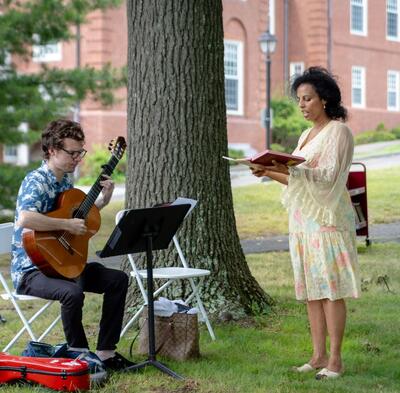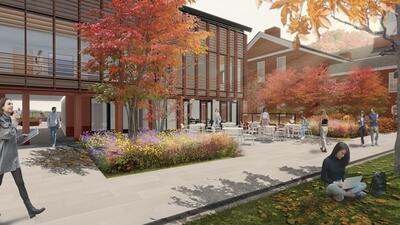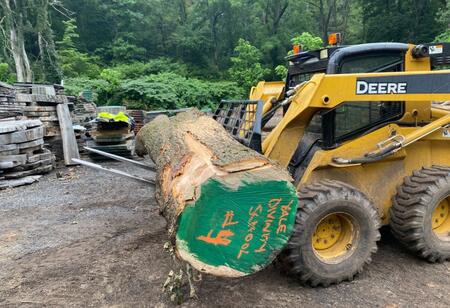By Joseph Becker
As construction on the Living Village began at YDS this summer, select trees were taken down to make way. Following the ethos of the project, YDS worked to ensure that as few as possible were felled—and that the trees would have a second life as part of the regenerative project. With the help of two Connecticut companies, a portion of the removed trees will be returned to campus in the form of furniture and other uses.
Additionally, as the project progresses, YDS will plant an abundance of new trees and other vegetation across the site of the living-building residence hall. Aiming to house students in a way that gives back to the environment more than it takes, the Living Village makes a moral and theological statement about the need for constructing buildings in harmony with nature.
Helping to put the Divinity School’s plans into action are City Bench and Hugo & Hoby. City Bench has begun the process of transforming the wood from the felled trees. At their facility on the east side of East Rock Park, they are now storing and drying the hemlock, pine, and oak logs for later milling.
Zeb Esselstyn of City Bench says, “We are happy to partner with Yale. There are millions of trees in metropolitan areas coming down each year that either go to the landfill or get chipped. If we can help sequester that carbon in the process of making furniture, that’s a good thing.”
Next, Hugo & Hoby, one of the only furniture companies in North America that is both a certified B Corp and 1% for the Planet Member, will take the milled wood and design and fabricate furniture for the Living Village. Working closely with the Yale project team, Hugo & Hoby will build functional objects that highlight the natural material’s history, structure, and beauty.
YDS Dean Greg Sterling says that he, like many in the YDS community, was saddened by the removal of the trees but heartened to know they would have a second life in the Living Village.
“The trees had special meaning to me,” said Sterling, who grew up in California. “The grove of pines between the Deanery and School reminded me of the pines in the Sierra Nevada Mountains of my boyhood, and the oak trees between the School and Divinity Farm reminded me of the oaks in the coastal hills and the foothills of the Sierra.
“While it was difficult for many of us to see the trees taken down, we take solace in knowing they will have new life in the Living Village—and in knowing that eventually twice as many trees will be planted as removed.”
 The reuse of the felled campus trees is only one piece of Living Village plans that center trees and other plants. The design also includes the following:
The reuse of the felled campus trees is only one piece of Living Village plans that center trees and other plants. The design also includes the following:
The Grove. The serpentine path from the Divinity Quadrangle will join with the existing pathway through the mature woodland to Saint Ronan Street. Young canopy, fruit, and nut trees will be planted to aid in the succession of the preserved mature canopy layer.
The Orchard. On the west side of the new building will be a large open space planted with a variety of orchard trees. Designed as a campus green, this space will function as a shade lawn, but its plants will all be fruit- or nut-bearing, making it a critical component of the agricultural landscape at the Divinity School.
 The Divinity Farm. The community garden established by YDS students, faculty, and staff is a much-loved piece of the campus landscape, and the Living Village will offer room for it to grow. Through the use of edible and medicinal plants in planting beds, the Living Village will showcase how agricultural practices can be included in a more formal and parklike design.
The Divinity Farm. The community garden established by YDS students, faculty, and staff is a much-loved piece of the campus landscape, and the Living Village will offer room for it to grow. Through the use of edible and medicinal plants in planting beds, the Living Village will showcase how agricultural practices can be included in a more formal and parklike design.
Kitchen Gardens. Located on the east porch, these gardens will connect with the sustainable cycles of the building systems, using recycled water for sub-surface irrigation and compost from kitchen waste. Food gardens will provide fresh herbs and vegetables for the community kitchens.
Water Commons. Through a series of constructed wetlands and rain gardens that step gently down the hillside, the Water Commons will filter rainwater and wastewater for reuse within the Living Village.
A regenerative living-learning community: Learn more about the Living Village at YDS
